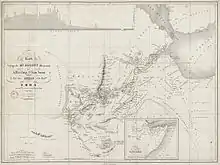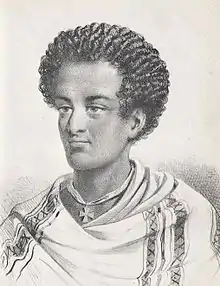Shewa
Shewa (Amharic: ሸዋ; Oromo: Shawaa; Arabic: شيوا), formerly romanized as Shua, Shoa, Showa, Shuwa (Scioà in Italian[1]), is a historical region of Ethiopia which was formerly an autonomous kingdom within the Ethiopian Empire. The modern Ethiopian capital Addis Ababa is located at its center.
.svg.png.webp)
The towns of Debre Berhan, Antsokia, Ankober, Entoto and, after Shewa became a province of Ethiopia, Addis Ababa have all served as the capital of Shewa at various times. Most of northern Shewa, made up of the districts of Menz, Tegulet, Yifat, Menjar and Bulga, is populated by Christian Amharas, while southern Shewa is inhabited by the Gurages and eastern Shewa has large Oromo and Argobba Muslim populations. The monastery of Debre Libanos, founded by Saint Tekle Haymanot, is located in the district of Selale, also known as Grarya, a former province of Abyssinia.[2] Modern Shewa includes the historical Endagabatan province.[3]
History

Shewa first appears in the historical record as a Muslim state, which G. W. B. Huntingford believed was founded in 896, and had its capital at Walalah.[4] In a recent discovery, a team of French archaeologists uncovered three urban centers believed to have been remnants of the former Sultanate of Ifat, with the Nora site in eastern Shewa being the most notable among them.[5][6]
Yekuno Amlak based his uprising against the Zagwe dynasty from an enclave in Shewa. He claimed Solomonic forebears, direct descendants of the pre-Zagwe Axumite emperors, who had used Shewa as their safe haven when their survival was threatened by Gudit and other enemies. This is the reason why the region got the name "Shewa" which means 'rescue' or 'save'. This claim is supported by the Kebra Nagast, a book written under one of the descendants of Yekuno Amlak, which mentions Shewa as part of the realm of Menelik I. Aksum and its predecessor Dʿmt were mostly limited to Northern Ethiopia and Eritrea during the 1st millennium BCE. However, Shewa eventually became a part of Abyssinia upon the rise of the Amhara Solomonic dynasty.[7] Dawit I and his successors stayed in Fatagar (part of Shewa) for a long time in Tobya (Yifat, Fatagar). The kingdom served as the birthplace of the future emperors Zara Yaqob and Eskender. Zara Yaqoub and Na'od would then make Tobya and Zway their capitals respectively.[8][9][10][11]

The Amhara Shewan ruling family was founded in the late 17th century by Negasi Krestos, who consolidated his control around Yifat. Traditions recorded about his ancestry vary: one tradition, recorded in 1840, claims his mother was the daughter of Ras Faris, a follower of Emperor Susenyos I who had escaped into Menz; another tradition told by Serta Wold, a councilor of Sahle Selassie, was that Negassie was a male-line descendant of Yaqob, the youngest son of Lebna Dengel, and thus assert descent from the ancient ruling Solomonic dynasty.[12]
Notable people
References
- Chisholm, Hugh, ed. (1911). . Encyclopædia Britannica. Vol. 24 (11th ed.). Cambridge University Press. p. 991.
- "Niras in Ethiopia". www.niras.com. 24 October 2011. Archived from the original on 18 November 2013. Retrieved 23 June 2023.
- Hassan, Mohammed. Oromo of Ethiopia (PDF). University of London. p. 234.
- G. W. B. Huntingford, The historical geography of Ethiopia from the first century AD to 1704, (Oxford University Press: 1989), p. 76
- Francois-Xavier, Fauvelle. Nora, a Medieval Islamic City in Ethiopia (14th-15th Centuries). ERC COG HornEast project.
- Hirsch, Bertrand (2006). "Reconnaissance de trois villes musulmanes de l'époque médiévale dans l'Ifat". Annales d'Éthiopie. 27: 134.
- The Nile: An Encyclopedia of Geography, History, and Culture. Abc-Clio. 12 May 2017. ISBN 9781440840418.
- Proceedings of the ninth international congress. Snippet view. 1988. p. 105.
{{cite book}}: CS1 maint: location missing publisher (link) - Lincei, Accademia Nazionale dei (1974). Problemi Attuali. 550. pp. Snippet view.
{{cite book}}: CS1 maint: location (link) CS1 maint: location missing publisher (link) - Lincei, Accademia Nazionale dei (1974). Problemi Attuali. p. 551.
- Lincei, Accademia Nazionale dei (1974). Problemi attuali Di scienza de cultura quaderno. Snippet view. p. 549.
{{cite book}}: CS1 maint: location missing publisher (link) - Mordechai Abir, Ethiopia: the Era of the Princes (London: Longmans, 1968), pp. 144ff.